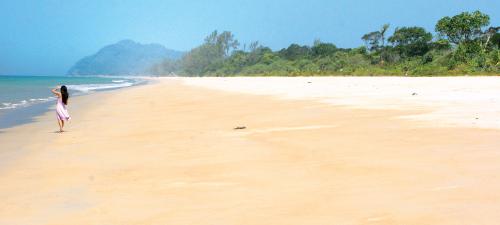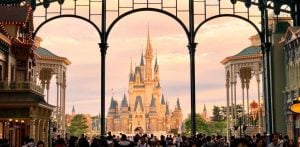Phuket Travel: Camp like a champ

PHUKET: In high season everyone is attempting the paradise-island cliche of beating the crowds. So standing on the beach front of Khao Lampi-Hat Thai Mueang National Park it’s time for an umbrella count. Nothing on the right, nothing on the left – that was easy enough. But perhaps it’s unfair to compare a pristine national park beach area with the umbrella-forested beaches of Phuket.
It’s Saturday, two hours before sunset, a person count was unequivocally more fair. A quick estimate of density per estimated 100 meters of beach for the several kilometers of off-white sand stretching out in both directions left a total of zero. With a friend still back at the tent, the beach was mine – all mine!
Despite the stunning, deserted beach landscape that fades into the horizon unobstructed by anyone and water that runs flat to the horizon with only a few lazy boats to break it’s surface, these aren’t the park’s selling points.
Khao Lampi-Hat Thai Mueang National Park is the weekend getaway for a family camping trip – that’s right camping – or just a fresh breath away from Phuket for expats in need.
Broken up into two main sections, the Lam Pi range, which comprises a stretch of mountains composed of mostly igneous rock and Hat Thai Mueang the nearly deserted beach, there is more than enough to explore.
GETTING THERE
Pile into the car, jump on to the motorbike, or take the inter-provincial bus from Terminal 1 towards Khao Lak, and cross the Sarasin Bridge to the mainland. Hold true to Highway 4 when 402 splits off a few kilometers past the bridge and ride it out to Thai Muang – following the signs to KhaoLak.
Anywhere between 30 minutes and an hour later, depending on your observance of speed limits, the road slides into the sleepy little town of Thai Muang and then takes a jagged 90 degree turn toward Khao Lak… let it go. Head straight under the arch. A couple kilometers farther, and you are on the beach front road with nowhere to go but the park.
CAMPING LIKE A PRO
The park’s facilities would make a US National Park Service Ranger chirp like a chipmunk if he ever had a chance to visit. The campground, shaded by large sparely distributed pine trees, stretches out across the road from the beach.
Inside the park headquarters, book one of the tents, which easily fit four people, probably making it a 12-person tent by industry standards. Once you’ve paid, a couple officers come out to set up the tent and hand over your pillow, sleeping bag and bed mat.
Lights (hidden in concrete tree stumps) remain on throughout the night, making it easy for those with small bladders to make it to the bathroom facilities. Though there aren’t hot showers, the facilities are spotless and cleaned regularly.
TURTLE TIME
When the kids, husband or friends start to become a bit of a bore and the sounds of the waves lapping against the beach become too much, pile back in the car.
Halfway down the beach road on your left is a must-see side-show treat: the Phang Nga Coastal Fisheries Research and Development Center.
Though clearly a research center, with it’s concrete tanks of marine life, Director Suparp Pripanapong has left the gates open for curious tourists and hundreds of school children eager to learn about the marine life just over the other side of the road.
The main draw for most people is the sea turtle conservation project. The project offers visitors the chance to see see baby sea turtles and juveniles, as well as full-grown turtles that are being mated in an attempt to have them use an artificial beach at the facility to lay eggs. Additionally, there are giant clams, a variety of reef fish, a few giant groupers and even a two-meter-long freshwater crocodile.
One of Dr Suparp’s many projects is seaweed, which isn’t so fascinating to look at, but is rather tasty. The quick growing variety clusters of pinhead sized “berries”.
EATING THE SEA GREENS
To get a real taste, however, it’s best to leave research center and head back towards Thai Mung. About 200 meters after the road bends away from the beach, there is a small restaurant that is doing some big things with what they are pulling out of the ocean.
I See Seafood Restaurant is hard to miss, as it appears they hired the Easter Bunny to decorate the place. Stripes of pastel pinks, yellows, blues and greens run across the interior of the open air establishment with matching chairs and tables.
The only must-have dish is the seaweed salad, which is the seaweed berry clusters served with the traditional dressings for som tom – warning, don’t put all the dressing on top as it will “melt” the seaweed clusters, just add a little at a time.
The whole-fish dishes are well above standard, with the fish in boiling plum and pork sauce, as well as the fish buried in a forest of fresh herbs, both stand out from the crowd. The shrimp and the softshell crab dishes, well… perhaps it’s best to leave some tasty surprises for those making the trip.
Back from a late lunch at I See Seafood Restaurant, it’s time to drive until the road ends inthe white sands of the 1,000 rai Thung Samet forest (a cajuput forest) to begin a hike, take a trip up to Lampi Waterfall, tackle the 622-meter peak of Yot Khao Khamin or maybe just wander back down to the beach and bask in the glory of having beaten the crowds.
THE TRIP AT A GLANCE
Park fees: Foreigners 100 baht, Thais 20 baht
Food: Cheap: 40 – 150 baht a plate
Tent: 150 baht a night
Sleeping gear (sleeping bag, pillow, bed mat): 60 baht per person
Activities: Beach-going, hiking and bird watching – free
Distance from Phuket: 28 kilometers from Sarasin Bridge
Phone: 076 417206 or 025 62076
Advice: Call ahead to make sure school groups aren’t booked for the same weekend if you want to ensure screaming and shrieking is kept at a minimum.
— Isaac Stone Simonelli
Latest Thailand News
Follow The Thaiger on Google News:
























